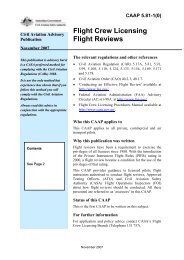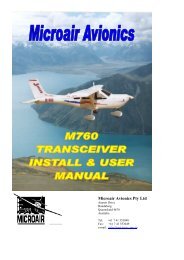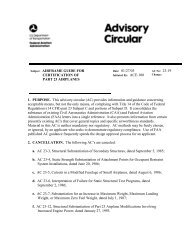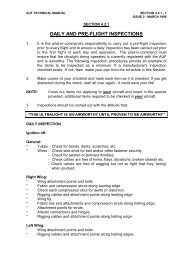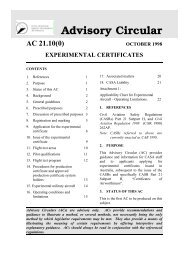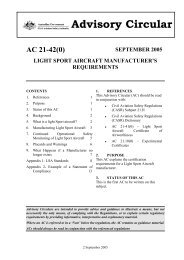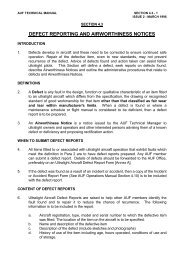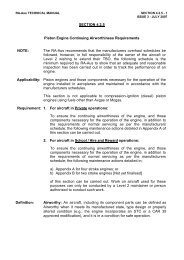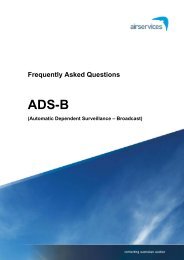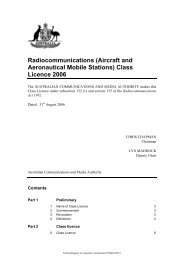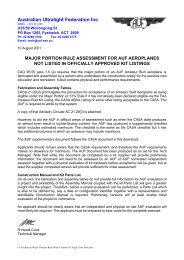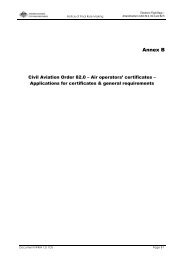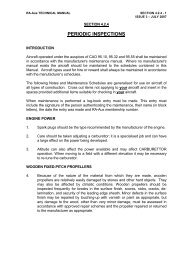Review of midair collisions involving general aviation ... - Fly Safe!
Review of midair collisions involving general aviation ... - Fly Safe!
Review of midair collisions involving general aviation ... - Fly Safe!
You also want an ePaper? Increase the reach of your titles
YUMPU automatically turns print PDFs into web optimized ePapers that Google loves.
There were also five <strong>collisions</strong> that occurred near the circuit area (that is, within 5 NM<br />
<strong>of</strong> an airport and with at least one aircraft arriving at, or departing from, that airport).<br />
These included one aeroplane-aeroplane collision at 1,500 ft with both aircraft on<br />
departure, one aeroplane-helicopter collision at about 1,500-2,000 ft with both aircraft<br />
on arrival, and three aeroplane-glider <strong>collisions</strong> at less than 2,000 ft with the<br />
aeroplane climbing.<br />
Of the 20 aeroplane-aeroplane <strong>collisions</strong> that occurred in or near the circuit area, 25<br />
aeroplanes were on training flights, 12 were on private flights, two were on passenger<br />
charter flights, and one was on an aerial work flight. At least 21 <strong>of</strong> the aeroplanes<br />
were being used for circuit training or practice. The aeroplane-helicopter collision<br />
involved two aircraft on aerial work flights, and the aeroplane-ultralight collision<br />
involved two aircraft on private flights. The seven aeroplane-glider <strong>collisions</strong><br />
involved five aeroplanes being used as glider tugs, although only one was actually<br />
towing a glider at or just prior to the accident. The other two aeroplanes were engaged<br />
in private and aerial work operations.<br />
Fifteen <strong>of</strong> the <strong>collisions</strong> in or near the circuit area occurred at one <strong>of</strong> the five major<br />
<strong>general</strong> <strong>aviation</strong> airports; that is, Archerfield, Bankstown, Jandakot, Parafield or<br />
Moorabbin. Thirteen <strong>of</strong> these <strong>collisions</strong> occurred during tower operating hours 7 ,<br />
although in one <strong>of</strong> these <strong>collisions</strong> neither pilot had yet contacted the tower<br />
(Moorabbin, 1970). Of the other two <strong>collisions</strong>, one (Jandakot, 2002) occurred just<br />
after the tower controllers had handed over to an air ground operator. The other<br />
collision (Moorabbin, 2002) occurred at night when the control zone was classified as<br />
a mandatory broadcast zone (MBZ). No other <strong>collisions</strong> have occurred in MBZs in<br />
Australia, which commenced in 1991.<br />
Most (10) <strong>of</strong> the 15 <strong>collisions</strong> at the major <strong>general</strong> <strong>aviation</strong> airports occurred prior to<br />
the introduction <strong>of</strong> General Aviation Aerodrome Procedures (GAAP) during tower<br />
hours in 1980. 8 The major change to operations at these airports in 1980 was the<br />
introduction <strong>of</strong> simultaneous contra-rotating circuit operations onto parallel runways<br />
(contra-circuits) at those airports with parallel runways. The previous procedures<br />
(known as a secondary control zone) involved all aircraft flying circuits in the same<br />
direction on the same side <strong>of</strong> the runways. Due to the high aircraft movement rates,<br />
tower controllers were only required to provide a limited service at secondary/GAAP<br />
airports, with aircraft separation being primarily a pilot responsibility. A review <strong>of</strong> the<br />
10 <strong>collisions</strong> that occurred prior to 1980 found that many <strong>of</strong> them were unlikely to<br />
have occurred if contra-circuit operations to parallel runways had been in use.<br />
Only one <strong>of</strong> the 37 <strong>collisions</strong> occurred in controlled airspace where air traffic services<br />
were providing a full control service. This collision occurred in the Coolangatta<br />
primary control zone in May 1988.<br />
There were six <strong>collisions</strong> <strong>involving</strong> pilots deliberately flying close to another aircraft.<br />
All were aeroplane-aeroplane <strong>collisions</strong>, and four involved formation flying activities.<br />
7 Due to the high movement rates and the types <strong>of</strong> operations at these airports during tower hours, tower controllers were only<br />
required to provide a limited service. Aircraft separation was primarily a pilot responsibility.<br />
8 GAAP commenced at Parafield in 1978 and at the other five airports during 1980. The level <strong>of</strong> air traffic control service was<br />
similar both before and after the introduction <strong>of</strong> GAAP.<br />
9



